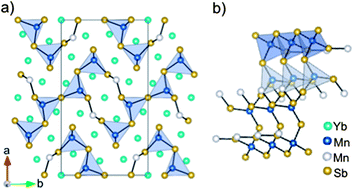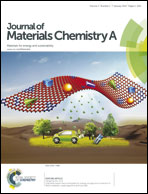Glass-like lattice thermal conductivity and high thermoelectric efficiency in Yb9Mn4.2Sb9†
Abstract
Motivated by excellent thermoelectric performance in the well-known Yb-based Zintl compounds Yb14MnSb11 and YbZn2−xMnxSb2, this study investigates the thermoelectric properties of Yb9Mn4.2Sb9. Unlike most transition metal containing Zintl phases, Yb9Mn4.2Sb9 contains a partially occupied Mn site and thus does not have a valence-precise stoichiometry. Samples were synthesized by direct ball milling of the elements, followed by hot pressing. Consistent with previous reports, X-ray diffraction and wavelength dispersive spectroscopy confirmed a narrow composition range near Yb9Mn4.2Sb9. High temperature measurements of the electronic properties of Yb9Mn4.2Sb9 indicate that it is a degenerate p-type semiconductor with a band gap sufficiently large for high temperature thermoelectric applications. Hall measurements reveal that Yb9Mn4.2Sb9 has a high extrinsic carrier concentration (∼1020 h+ cm−3), which is due to the deviation from the theoretical “Zintl composition” of Yb9Mn4.5Sb9. The measured carrier concentration coincides with the optimum concentration predicted using a single parabolic band model. Measurements of the thermal diffusivity and heat capacity reveal an extremely low, temperature-independent lattice thermal conductivity in this compound (κL < 0.4 W mK−1), which is due to both the large unit cell size (44 atoms per primitive cell) and substantial disorder on the Mn site. This favorable combination of optimized electronic properties and low lattice thermal conductivity leads to a promising figure of merit at high temperature (zT = 0.7 at 950 K).


 Please wait while we load your content...
Please wait while we load your content...